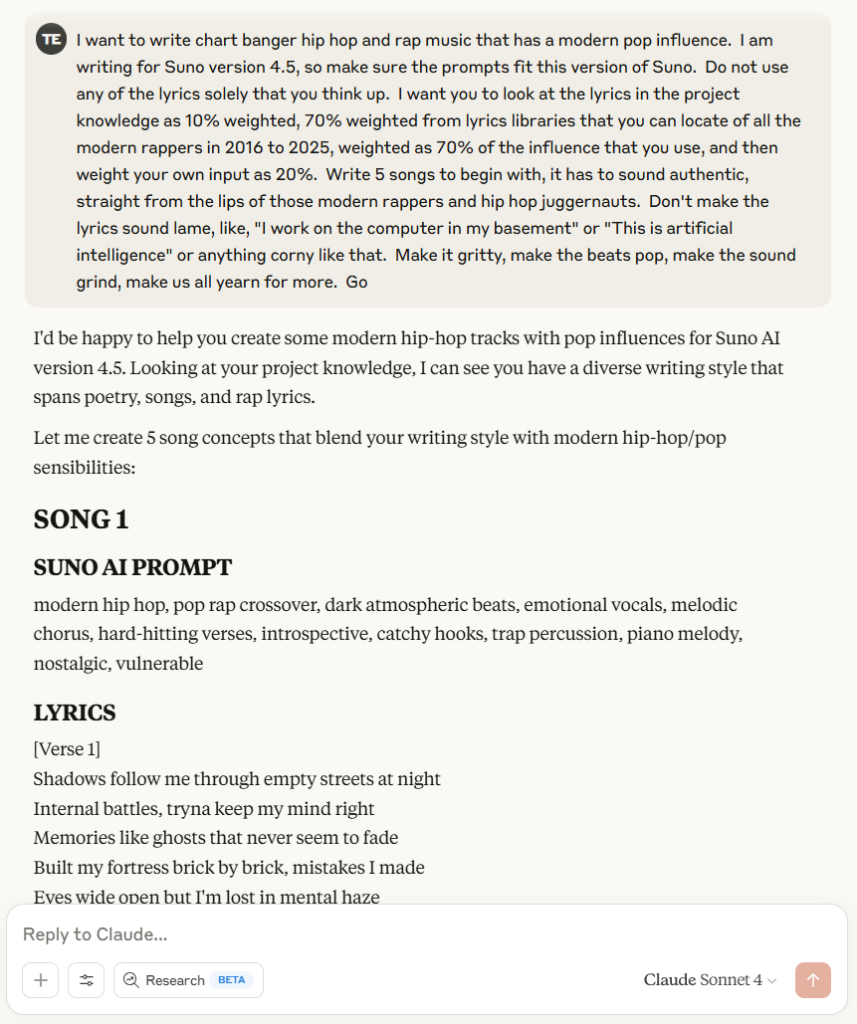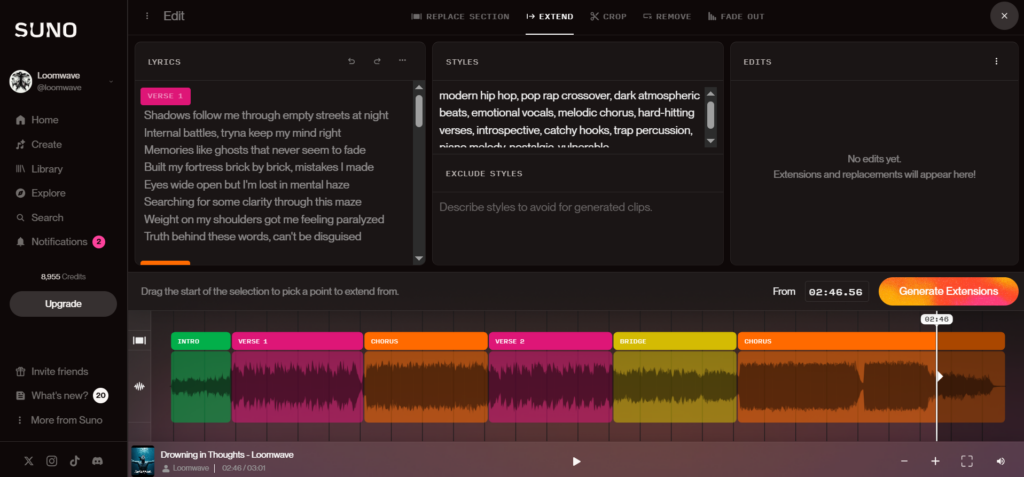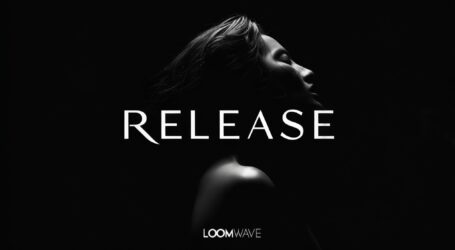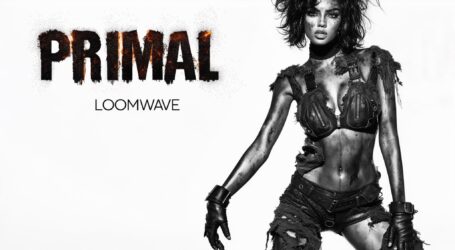The Perfect Storm of AI Creativity
In the early hours of May 5th, 2025, something magical happened in my garage studio. What started as an experiment in emulating chart-topper styles using AI tools culminated in “Drowning In Thoughts” – a track that perfectly demonstrates how three AI platforms can work in harmony to create professional-grade music. This isn’t just another AI music tutorial; it’s a deep dive into how Claude AI, Suno v4.5, and Luma Dream Machine form an unprecedented creative trinity for independent artists.
Claude AI: The Lyrical Architect
The foundation of “Drowning In Thoughts” began with a strategic approach to prompt engineering. Rather than letting Claude default to its typical AI-focused themes, I implemented a chart-topper emulation strategy. I asked Claude to analyze successful hip-hop artists and their signature styles, then craft lyrics that would genuinely compete in today’s music landscape.
What Makes Claude Exceptional for Lyrics:
- Contextual Understanding: Claude grasps complex emotional themes and can weave them into coherent narratives
- Style Adaptation: Unlike generic lyric generators, Claude can emulate specific artist styles when given proper context
- Iterative Refinement: The ability to request modifications, tone adjustments, and structural changes in real-time
- Cultural Relevance: Claude understands contemporary references and can incorporate them naturally
My Claude Workflow:
- Initial prompt with style references and emotional direction
- Request for multiple verse variations
- Chorus refinement through specific feedback
- Final polish with rhythm and flow considerations
The key breakthrough came when I realized Claude works best when treated as a collaborative partner rather than a simple prompt-response tool. By explaining my vision for the track’s emotional arc, Claude delivered lyrics that felt authentic rather than algorithmically generated.

Suno v4.5: The Musical Genius
If Claude is the architect, Suno v4.5 is the master builder. The latest version of Suno represents a quantum leap in AI music generation, and “Drowning In Thoughts” showcases exactly why this tool is revolutionizing independent music production.
Suno v4.5 Standout Features:
- Vocal Quality: The generated vocals on this track are indistinguishable from professional studio recordings
- Genre Versatility: Seamless transitions between hip-hop verses and melodic choruses
- Audio Fidelity: 44.1kHz output that requires minimal post-processing
- Creative Interpretation: Suno doesn’t just follow instructions; it adds creative flourishes that enhance the original concept
The Suno Magic Moment: What consistently amazes me about Suno v4.5 is its ability to surprise. I fed it Claude’s lyrics with a basic hip-hop prompt, expecting a decent track. Instead, Suno delivered something that made me immediately think, “This needs to be released.” The AI understood the emotional weight of the lyrics and created a musical arrangement that amplified rather than competed with the words.
Technical Advantages:
- Clean stems that separate easily for mastering
- Consistent tempo and key throughout extensions
- Natural-sounding vocal inflections and ad-libs
- Professional-grade instrumental arrangements
The iteration process with Suno has become incredibly efficient. Unlike earlier versions that required multiple attempts to achieve usable results, v4.5 consistently delivers broadcast-quality audio on the first or second generation.

Luma Dream Machine: The Visual Storyteller
While audio is the heart of any track, visual presentation can make or break a song’s success on platforms like YouTube. Luma Dream Machine has transformed how I approach album artwork and music video creation for my AI-generated tracks.
Luma’s Creative Strengths:
- Conceptual Understanding: Input abstract concepts and receive visually stunning interpretations
- Animation Capabilities: Static images become dynamic, engaging visuals
- Style Consistency: Maintains artistic coherence across multiple generated images
- Professional Quality: Output suitable for commercial release without additional editing
My Luma Process for “Drowning In Thoughts”:
- Conceptual prompt based on the song’s emotional themes
- Generate multiple album cover variations
- Select the most compelling design
- Create animated version for video background
- Export at optimal resolution for video editing
The visual component has become crucial for audience engagement. Luma-generated artwork consistently receives comments about its professional appearance, and the animation capabilities mean I can create dynamic music videos without expensive equipment or software.

The Integration Workflow: Where Magic Happens
The real power emerges when these three tools work in sequence. Here’s the refined workflow that produced “Drowning In Thoughts”:
Phase 1: Conceptual Development (Claude)
- Define emotional themes and target audience
- Generate initial lyrics with style specifications
- Refine through iterative feedback
- Finalize structure and flow
Phase 2: Musical Creation (Suno)
- Input Claude-generated lyrics with genre specifications
- Generate multiple versions for comparison
- Select best output or extend promising segments
- Export final audio at highest quality
Phase 3: Visual Creation (Luma)
- Develop visual concepts that complement the audio
- Generate static album artwork
- Create animated versions for video content
- Ensure visual consistency with track’s emotional tone
Phase 4: Post-Production Integration
- Master audio using BandLab’s AI mastering tools
- Compile video using VSDC Video Editor
- Add audio spectrum visualization
- Export for multiple platform optimization
Cost-Effectiveness Analysis
One of the most compelling aspects of this AI trinity is the economic advantage for independent artists:
Traditional Route Costs:
- Professional songwriter: $500-2000
- Studio recording: $100-300/hour
- Professional mixing/mastering: $200-800
- Graphic designer: $300-1500
- Music video production: $2000-10000
- Total: $3100-14600
AI Trinity Route:
- Claude AI subscription: $20/month
- Suno Pro subscription: $24/month
- Luma credits: $30/month
- Total: $74/month (unlimited creation)
The return on investment becomes apparent after creating just one track per month, but the real advantage lies in the creative freedom to experiment without financial constraints.
Quality Assessment: Professional vs. AI-Generated
After releasing dozens of tracks using this workflow, the quality consistently surprises industry professionals. “Drowning In Thoughts” exemplifies several quality markers:
Audio Production:
- Clean vocal separation for remixing potential
- Professional-level mixing without additional processing
- Dynamic range suitable for radio play
- No artifacts or digital distortion typical of AI generation
Lyrical Content:
- Coherent narrative structure throughout
- Natural rhyme schemes and internal rhythms
- Emotionally resonant themes that connect with listeners
- Contemporary relevance without forced cultural references
Visual Presentation:
- Album artwork that stands alongside major label releases
- Consistent artistic vision across promotional materials
- Animation quality suitable for television broadcast
- Professional typography and composition
Limitations and Honest Assessment
While this AI trinity is powerful, it’s important to acknowledge limitations:
Claude Limitations:
- Occasional repetitive phrases across different songs
- Sometimes requires multiple iterations to achieve desired tone
- Limited understanding of complex musical terminology
- Can default to clichéd themes without specific guidance
Suno Limitations:
- Occasional audio artifacts in complex arrangements
- Limited control over specific instrumental choices
- Sometimes struggles with unusual song structures
- Credit system can be expensive for heavy experimentation
Luma Limitations:
- Inconsistent results with highly specific prompts
- Limited animation duration for longer video content
- Occasional surreal elements that don’t match track themes
- Processing time can be lengthy during peak usage
The Future of Independent Music Production
“Drowning In Thoughts” represents more than just a successful track; it’s proof of concept for a new paradigm in music creation. The combination of Claude’s lyrical intelligence, Suno’s musical sophistication, and Luma’s visual creativity democratizes professional-level content creation.
Industry Implications:
- Independent artists can compete with major label production values
- Creative experimentation becomes financially viable
- Faster iteration cycles enable more refined artistic output
- Global accessibility breaks down geographical barriers to music production
Personal Creative Evolution: Working with these tools has fundamentally changed my approach to music creation. Instead of being limited by technical skills or budget constraints, I can focus entirely on creative vision and emotional expression. The AI handles technical execution while I guide artistic direction.
Practical Recommendations for Aspiring AI Music Producers
Based on extensive experience with this workflow:
Start with Claude:
- Invest time in learning effective prompt engineering
- Develop a library of successful prompt templates
- Practice iterative refinement techniques
- Study successful lyrics in your target genre
Master Suno:
- Experiment with different prompt styles to understand capabilities
- Learn to identify promising partial generations for extension
- Develop an ear for AI-generated artifacts and how to avoid them
- Build a collection of successful prompts for different moods
Leverage Luma:
- Create consistent visual branding across your releases
- Experiment with abstract concepts for unique artwork
- Learn animation timing for optimal video engagement
- Develop a signature visual style that complements your music
The key to success with this AI trinity lies not in the tools themselves, but in developing artistic vision and learning to guide artificial intelligence toward authentic creative expression. “Drowning In Thoughts” succeeded because it emerged from genuine artistic intention amplified by AI capability, not replaced by it.
Toni Eleninovski is an independent AI music producer and creator of the Loomwave catalog. Follow his latest releases on Spotify and YouTube, where he continues to push the boundaries of AI-assisted music creation.

Diary Of A Mad Chaos is a daily diary written from March 1996 until today, of which individual books and book series have been created, namely “The Lost Years” an exploration of young, entwined love, the “Wubao In China (猎艳奇缘)” book series which provides an extensive comparative analysis of the cultural differences between Eastern and Western societies, and the book titled “Foreigner (华人)” an exploration of race relations in Australia.










